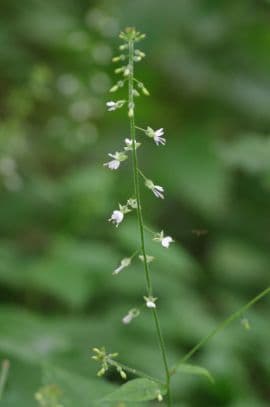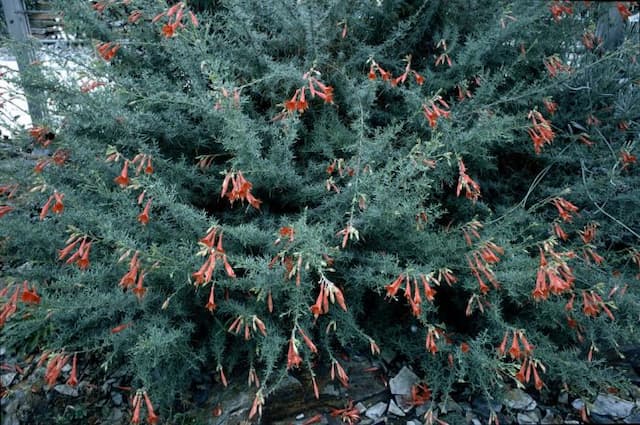Fuchsia Fuchsia 'Mrs W.p. Wood'

ABOUT
The Fuchsia 'Mrs W.p. Wood' is a captivating plant known for its distinctive and showy flowers. The blooms dangle elegantly from the stems and are a striking two-tone color. Typical of fuchsias, the flowers feature a graceful teardrop shape, with a bold, deep pink to purplish-red outer layer that encases a soft purple to violet inner layer, often flaring out at the bottom into a skirt-like form. The delicate petals are long, slender, and sometimes slightly recurved, which adds to the unique appeal of the flowers. Each bloom is adorned with long, protruding stamens, which have a lighter color, usually pink to white, adding another layer of contrast to the already vibrant flowers. The sepals, which are the part of the flower that enclose and protect the petals before they bloom, are usually in shades of bright pink to red, complementing the overall color scheme. The foliage of 'Mrs W.p. Wood' is comprised of dark green leaves, which have a slight glossy sheen and an elliptical to slightly ovate shape with a serrated edge. The leaves are arranged oppositely along the stems, providing a lush background that makes the colorful blooms pop even more. These combined features of striking flowers and attractive foliage make the Fuchsia 'Mrs W.p. Wood' a favorite among garden enthusiasts and a popular choice for hanging baskets and garden beds where their extraordinary flowers can be fully appreciated.
About this plant
 Names
NamesFamily
Onagraceae
Synonyms
Lady's Eardrops, Fairy Bells, Fuchsia
Common names
Fuchsia 'Mrs W.p. Wood'.
 Toxicity
ToxicityTo humans
Fuchsia is generally considered non-toxic to humans. Most species of Fuchsia, including Fuchsia 'Mrs W.p. Wood', can be safely handled and are not known to cause poisoning if ingested. However, it is always best practice to avoid eating ornamental plants as they are not intended for consumption and individual reactions to plants can vary.
To pets
Fuchsia is also generally considered non-toxic to pets. It is not known to cause significant symptoms of poisoning if ingested by animals. Despite this, pets may experience mild gastrointestinal discomfort if they consume large quantities of the plant, but there are no serious toxic effects expected specifically from Fuchsia 'Mrs W.p. Wood'. As with humans, it is advisable to prevent pets from eating ornamental plants as a precaution.
 Characteristics
CharacteristicsLife cycle
Perennials
Foliage type
Deciduous
Color of leaves
Green
Flower color
Mixed
Height
1-2 feet (30-60 cm)
Spread
1-2 feet (30-60 cm)
Plant type
Shrub
Hardiness zones
9
Native area
Central and South America
Benefits
 General Benefits
General Benefits- Ornamental Appeal: Fuchsia 'Mrs W.p. Wood', commonly known as Fuchsia, has striking pendulous flowers that add aesthetic value to gardens and landscapes.
- Hummingbird Attractant: The tubular flowers of the Fuchsia are perfect for attracting hummingbirds, which are natural pollinators and delight to watch.
- Bee Friendly: Fuchsias also attract bees, supporting pollinator populations and thereby benefiting the local ecosystem.
- Versatile Plant: Suitable for growing in hanging baskets, containers, and borders, Fuchsia offers flexibility in garden design and space utilization.
- Shade Tolerance: Fuchsia thrives in part shade, making it a good choice for garden spots that receive less direct sunlight.
- Long Blooming Season: Fuchsias have a lengthy flowering period from spring to fall, providing extended color and interest in the garden.
 Medical Properties
Medical PropertiesThis plant is not used for medical purposes.
 Air-purifying Qualities
Air-purifying QualitiesThis plant is not specifically known for air purifying qualities.
 Other Uses
Other Uses- Fuchsia 'Mrs W.p. Wood' can be used as a natural dye, with its blossoms potentially creating subtle pink or purple hues on fabrics.
- The blossoms can be crystallized and used as edible decorations for desserts and cakes, offering a vibrant pop of color.
- Fuchsias can be integrated into educational programs or botany lessons to study plant anatomy and pollination, using their distinctive flowers.
- A crafting material, where dried fuchsia flowers are incorporated into potpourri mixes or pressed flower art.
- In the creation of floral waters or perfumes, fuchsia flowers may impart a delicate scent to homemade cosmetic products.
- The plant can be trained as a bonsai, offering a unique horticultural challenge and an ornamental display.
- Fuchsia flowers can serve as natural indicators for pH levels in soil, as their color might vary slightly with the acidity or alkalinity of the soil.
- Used in food plating for high-end culinary presentations, adding an exotic and aesthetic touch to the dish.
- As part of a sensory garden, fuchsia flowers contribute varied textures and visual stimulus, beneficial for therapeutic gardens.
- In photography and art, fuchsia plants offer vivid subject matter for botanical illustration or close-up photography, especially due to their unusual shapes.
Interesting Facts
 Feng Shui
Feng ShuiThe plant Fuchsia is not used in Feng Shui practice.
 Zodiac Sign Compitability
Zodiac Sign CompitabilityThe plant Fuchsia is not used in astrology practice.
 Plant Symbolism
Plant Symbolism- Confiding Love: Fuchsias are often associated with love and confiding in someone, suggesting a trusting, deep relationship.
- Good Taste: The elegant appearance of the fuchsia flower symbolizes good taste and sophistication.
- Ardent Love: The vibrant colors and unique shape of fuchsia blooms can represent a passionate and intense affection.
- Elegance and Grace: Fuchsias carry an air of refinement and beauty, making them a symbol of gracefulness and poise.
 Water
WaterFuchsias, including the Fuchsia 'Mrs W.p. Wood', prefer a consistently moist soil and should be watered whenever the top inch of soil feels dry, typically around twice a week. Avoid letting the soil dry out completely as this can cause stress to the plant. Provide a thorough soaking so that water reaches the entire root system. On average, you should aim for about 1 gallon of water per plant, per week during the growing season, though this may vary based on temperature and humidity conditions.
 Light
LightLady's eardrops, as this variety of fuchsia is commonly known, thrive in partial shade where they receive filtered sunlight. They should be protected from the harsh afternoon sun, so a spot that offers morning sunlight followed by dappled shade in the afternoon is ideal. Direct and intense sunlight can scorch their leaves and flowers, so careful positioning is key for their health and flourishing.
 Temperature
TemperatureLady's eardrops favor cool to moderate temperatures, thriving in a range between 60°F and 75°F. They can tolerate a minimum temperature of around 50°F for short periods but sustained cold below this can damage or kill the plant. Maximum tolerable temperature is about 80°F, above which the plants may start to experience stress. Ideal growing conditions would avoid extremes and stay within their preferred temperature range as much as possible.
 Pruning
PruningPruning Lady's eardrops is important to promote bushier growth and more flowers. Prune in late winter or early spring before new growth begins. Remove any dead or damaged branches and cut back about a third of the plant to encourage new shoots. Regularly deadheading the spent flowers will also encourage further blooming throughout the season.
 Cleaning
CleaningAs needed
 Soil
SoilLady's eardrops thrive in a well-draining, fertile soil mix with high organic matter content, such as a blend of loam, peat, and perlite or sand. Ideal soil pH for lady's eardrops is slightly acidic to neutral, ranging from 6.0 to 7.0.
 Repotting
RepottingLady's eardrops should generally be repotted every 1-2 years or when the plant becomes root-bound, typically in spring before the onset of the new growth season.
 Humidity & Misting
Humidity & MistingLady's eardrops prefer high humidity levels, ideally between 60-70%. To maintain optimal humidity, mist the plant regularly or place it on a humidity tray.
 Suitable locations
Suitable locationsIndoor
Provide bright, indirect light and consistent moisture.
Outdoor
Place in partial shade, shelter from strong winds.
Hardiness zone
10-11 USDA
 Life cycle
Life cycleThe Fuchsia 'Mrs W.p. Wood', commonly known as Hardy Fuchsia, begins its life as a seed, germinating in moist, well-draining soil with plenty of warmth and indirect sunlight. Upon germination, the seedling emerges and grows into a young plant, developing a root system and foliage. As it matures, it enters the vegetative stage, where it grows leaves and stems vigorously. With adequate care, the plant reaches the flowering stage, producing vibrant, pendulous flowers that are often purple and pink, which attract hummingbirds and other pollinators. Following pollination, these flowers develop into small fruit with seeds, completing the reproductive cycle. As a perennial, the Hardy Fuchsia may experience dormancy in colder seasons, to return with new growth in the spring.
 Propogation
PropogationPropogation time
Spring-Early Summer
Propogation: Fuchsia 'Mrs W.p. Wood', commonly known as fuchsia, is typically propagated through softwood cuttings. This method is the most popular because it is straightforward and generally yields good results. The best time to take these cuttings is late spring to early summer when the plant is growing actively. Cuttings should be about 2 to 4 inches (5 to 10 centimeters) long, including several leaves. The lower leaves are removed, and the stem is cut just below a node. The cut end is often dipped in rooting hormone to encourage root development before being placed in a potting mix. The pot is then covered with a plastic bag or placed in a propagator to maintain high humidity, and cuttings are kept in indirect light until they root, which usually takes about 3 to 4 weeks.









![Fuchsia [Electric Lights]](/_next/image?url=https%3A%2F%2Fplants-admin.emdemapps.com%2Fimages%2Fplants%2F%2Fimages%2F604b5ba9b6455.png&w=640&q=75)